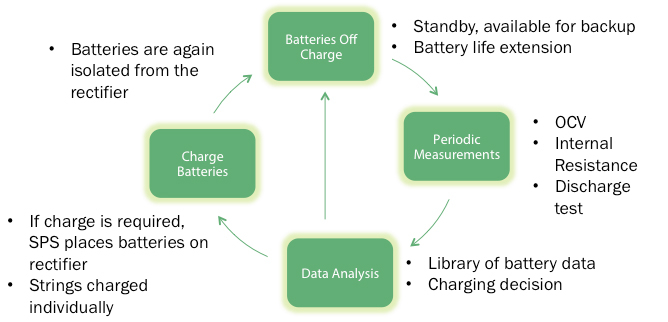In this three-part article series, Andrew Burger of Energy Central outlines the systematic risk that an increasingly unreliable energy grid poses to the telecom industry and the way Americans communicate, do business, and protect against crises. Andrew speaks with Servato CEO Chris Mangum on the subject:
[…]In just two weeks the ICT industry will gather in Orlando for the biggest show of the year, ISE EXPO. Each year, ISE brings in telecom professionals from all 50 states and many countries for educational sessions and an exhibit hall with hundreds of vendors.
[…]Adaptive Charging: Benefits of Adaptive Charging (Part 4 of 4)
This article originally appeared in the 2Q17 edition of Battery Power Magazine. The article is published on our blog in 4 parts. You can access the full article here.
Adaptive Charging Extends Battery Life and Delivers other Benefits
Continuous charging as a method of maintaining standby batteries at a full state of charge has been standard for many years, but has serious negative consequences that can add significant cost to battery management budgets. Continuous float charging accelerates battery failure due to increased temperature, grid corrosion, plate degradation and dry-out.
Adaptive Charging: Principles Adaptive Charging (Part 3 of 4)
This article originally appeared in the 2Q17 edition of Battery Power Magazine. The article is published on our blog in 4 parts. You can access the full article here.
[…]Adaptive Charging: Intermittent or Periodic Charging vs Adaptive Charging (Part 2 of 4)
This article originally appeared in the 2Q17 edition of Battery Power Magazine. The article is published on our blog in 4 parts. You can access the full article here.
[…]Adaptive Charging: The Inefficiencies of Continuous Float Charging (Part 1 of 4)
This article originally appeared in the 2Q17 edition of Battery Power Magazine. The article is published on our blog in 4 parts. You can access the full article here.
The accelerating growth of Internet of Things (IoT) devices and applications require continuous investment in telecommunications networks to provide the connectivity for millions of new devices. As more devices connect to the Internet, service outages become more impactful to the people and businesses that rely on IoT applications. Safeguarding telecom networks from power outages is the Valve Regulated Lead Acid (VRLA) battery. Stationary VRLAs are ubiquitously used at broadband, wireless and cable sites, and millions are in service across the country. Unfortunately, almost all of these batteries, and thus the sites that depend on them, are vulnerable to a reliability-damaging standard: float charging. While float charging will maintain batteries at full charge, it can have a damaging impact on the service life of the battery, which introduces risk and increases maintenance costs. There is a better way to charge batteries, Adaptive Charging, that mitigates the degrading effects of float charge, extending battery life and reducing maintenance costs.
[…]It’s Time to Upgrade Legacy Alarms:
Capital dollars are any telco’s most prized resource, but there is another resource that is increasingly scarce within telecommunications companies large and small: technician man-hours.
[…]Powering your network vision (Reality Check)
This article originally appeared on RCR Wireless' website on June 13th, 2017. To read the original article, click here.
The internet is now the “reason for being” for most wireless and wireline service providers. Indeed, wireless and wireline networks are becoming the internet (homage to Eric Schmidt’s original vision of the network becoming the computer). These broadband networks are increasingly looking and working less like “telecom” networks and more like wide-area IT networks as switches give way to routers and lots and lots of “things” get connected to them. And, of course, none of the internet infrastructure works if it is not powered, which calls to mind yet another critical but distinct network – the power distribution infrastructure of the power utility. Despite being regulated by the same PUC commissioners, planning between and among carriers and power utilities is pretty much non-existent. Their network planning sessions are disconnected, parallel discussions that need to be more integrated if we are to ensure that the Internet is always powered on.
[…]Free eBook: Adaptive Charging Allows us to Double VRLA Battery Life
In August 2016 Servato Business Development Manager Alex Rawitz presented the principles of Adaptive Charging at the Battery Power conference in Denver, CO.
The eBook, based on the presentation, describes:
- The shortcomings of continuous float charging
- Principles of Adaptive Charging and how Servato's hardware and software administers this charging regimen in the field automatically
- Case studies that demonstrate the power of Adaptive Charging to extend battery life, improve battery State-of-Health insight and reduce costs of maintenance.
After several relatively quiet years since Hurricane Sandy devastated the Northeast, 2016 has already seen a slew of powerful storms that have people worried. In recent months there was Hurricane Hermine that did not cause much lasting damage but did dump heavy rains on the Eastern Seaboard. Away from the Atlantic, Tropical Storm Newton brought unusual weather to the desert Southwest, and Super Typhoon Meranti, the strongest storm of 2016 which packed winds of up to 220 mph, hit Taiwan and China. Hurricane Matthew is bringing another round of heavy wind and rain to the Southeast.
Outside of these high profile storms, people across the United States watched as Baton Rouge and the surrounding Louisiana lowlands grappled with what was dubbed a “1,000 year storm,” with rains of a magnitude only seen every 40-50 generations. The flooding caused havoc in Louisiana and displaced tens of thousands.
Preparing for and managing the consequences of these natural disasters is important to mitigating the impact they can have. The most important element to disaster recovery are communications networks. These networks enable accurate response services and provide preventative and recovery crews the intelligence they need to make the right decisions under high-pressure circumstances.
Given the importance of communications infrastructure – particularly for emergencies like hurricanes – it is not surprising that operators take precautions to prevent downtime. After physical damage to the network equipment, the most critical element of communications infrastructure during disasters is power. Power outages are common during storms and preventing outages from impacting service is a key engineering and operational focus for telcos.
The most significant component for contingency planning and maintaining power to critical telecommunications networks during outages are Valve Regulated Lead Acid (VRLA) batteries. Even for sites that retain a generator, VRLA batteries serve as the power bridge from the start of an outage to when the generator is fully operational. Many more telecom sites are too small to justify a generator, and hundreds of thousands of sites across the country rely exclusively on batteries for backup power.
Maintaining these batteries is a major challenge for telcos. For decades the industry has relied on technicians to perform manual maintenance checks on batteries at sites. The sheer number of sites makes even an annual check of the batteries extraordinarily difficult to achieve, and so the reality is that most sites do not see regular battery checks or timely replacements. Instead, batteries are replaced on fixed cycles regardless if they are dead or have many years of life remaining. In some cases, they are not checked until a service outage calls attention to the battery failure.
Servato is helping telcos, and other companies that maintain batteries for backup power improve reliability and save money on battery maintenance. Servato solutions are designed not just to improve proactive measures for battery maintenance, but streamline site restoration decisions during emergency situations where outages have affected multiple sites.
[…]








